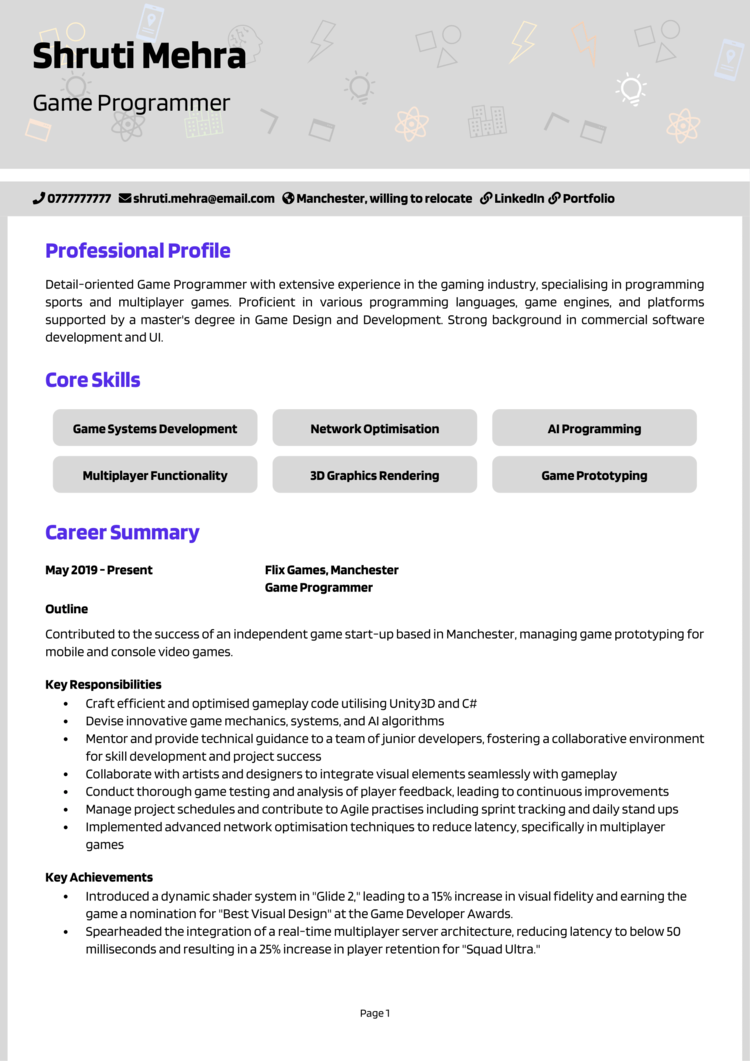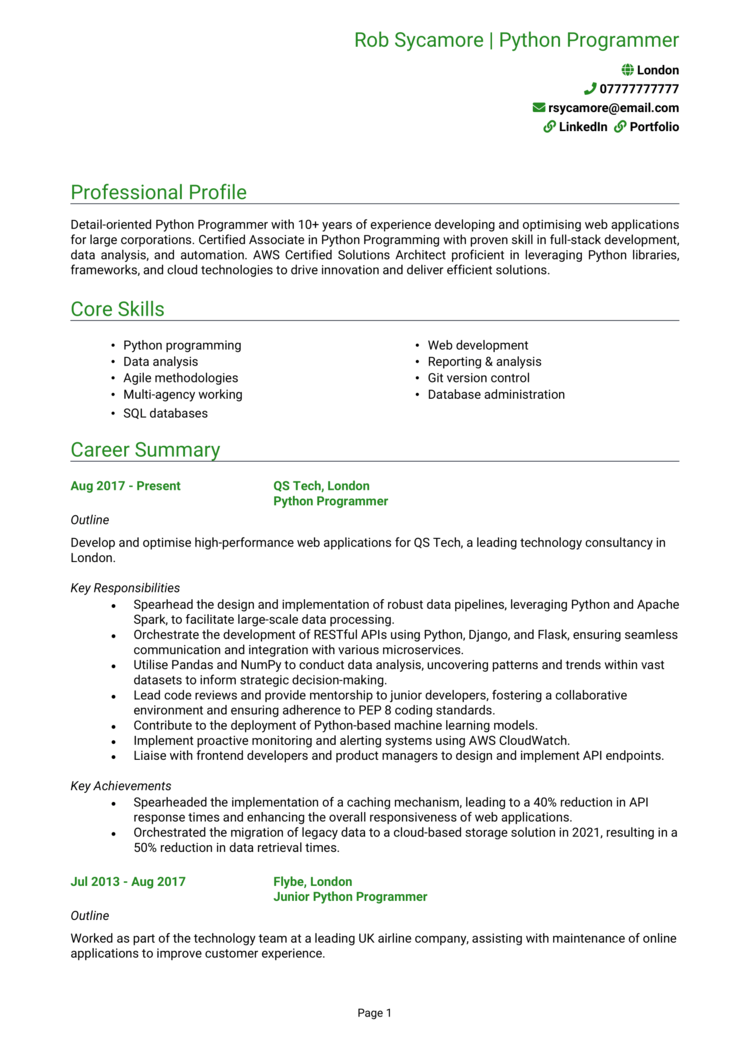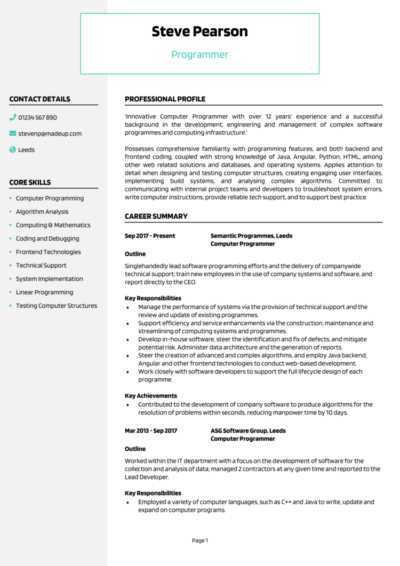Debugging your CV? Let’s make sure it’s free of errors and running properly before sending it off to recruiters.
As a programmer, your job is to make complex systems run smoothly. Now it’s time to do the same for your career. With this guide and its Programmer CV examples, you’ll write a CV that opens doors to exciting opportunities in tech.
Programmer CV

Entry Level Programmer CV

Game Programmer CV

Junior Programmer CV

Python Programmer CV

How to write your Programmer CV
Learn how to create your own interview-winning Programmer CV with this simple step-by-step guide.
A Programmer CV needs to show that you’ve got the technical skills, creativity, and attention to detail to tackle complex projects. Employers want to know you’re proficient in key programming languages, have a knack for debugging, and can collaborate effectively with teams.
Your programming skills are the foundation of your career, but how you present them in your CV can make or break your job search. These steps will teach you how to write a CV that gets noticed and secures interviews.
Programmer CV structure


Your CV structure should be clear and organised like well-documented code, and not force recruiters to decipher it like a cryptic bug. A clear layout ensures they can quickly see your skills, qualifications, and experience.
Here’s how you should structure your Programmer CV:
- Name and contact info – Keep your contact details at the top so hiring managers can reach you easily. You can have a picture of yourself, but it’s always optional.
- Profile – Start with a summary of your technical expertise, programming accomplishments, and career goals.
- Core skills – Quickly bullet point your technical abilities, such as proficiency in Python, JavaScript, or database management.
- Work experience – List off your previous roles in reverse chronological order, showcasing your programming achievements.
- Education – Include degrees, certifications, awards, and any relevant technical training.
- Additional info – This section is optional, but it’s a good place for hobbies and interests that complement your professional profile.
Best format for a Programmer CV


A poorly formatted CV is like spaghetti code – it’s a tangled mess that no one wants to work through. Keep it neat and professional. A solid CV format ensures recruiters can focus on your technical expertise, not visual mistakes.
Here’s how to format your Programmer CV effectively:
- Bullet points – Keep sentences concise and impactful, using bullet points to organise responsibilities.
- Divide sections – Use clear headings to make navigation simple for busy recruiters.
- Use a clean font – Along with an appropriate colour scheme, ensure your font is easy for the recruiter to read.
- Keep it the right length – Stick to a two-page length limit to highlight your key achievements without unnecessary extras that belong in a cover letter.
The best way to write a Programmer CV profile


XX
Your profile, also known as a personal statement for junior candidates, is your headline, designed to catch a recruiter’s attention and convince them you’re the programmer they need. You’ll need to convey the value you’ll provide to any company that hires you.
Programmer CV profile examples
Profile 1
Experienced Programmer with six years of expertise in developing robust software solutions for e-commerce and financial services. Skilled in Python, Java, and JavaScript, with a strong focus on creating scalable applications and optimising system performance. Adept at collaborating with cross-functional teams to deliver projects within tight deadlines.
Profile 2
Dedicated Programmer with four years of experience specialising in mobile app development and backend systems for tech startups. Proficient in Swift, Kotlin, and Node.js, with a passion for writing clean, efficient code. Experienced in delivering innovative applications that enhance user experiences and meet business objectives.
Profile 3
Proficient Programmer with over eight years of experience in enterprise-level software development, focusing on cloud-based systems and API integration. Skilled in C#, .NET, and SQL, with a strong track record of designing and implementing secure, high-performance solutions. Experienced in mentoring junior developers and managing complex development cycles.
What to include in your Programmer CV profile
Here are some tips on what to include in your Programmer CV profile:
- Where you’ve worked – Mention software firms, startups, or industries where you’ve applied your coding skills.
- Your top qualifications – Outline degrees, certifications, or coding bootcamps you’ve completed.
- Technical expertise – Quickly mention your proficiency in programming languages or frameworks.
- Notable projects – Reference standout contributions, such as building scalable applications or solving critical bugs.
- Programming languages – Mention the coding languages you’re proficient in and would be able to put to use in your new role.
- Team collaboration – Highlight your ability to work with cross-functional teams, such as developers, designers, or stakeholders.
Core skills section


This section is your tech stack – your chance to showcase the programming languages, frameworks, and tools you’ve mastered. Tailor your CV skills to best reflect the skills for the precise job you’re applying for, as they can vary widely between roles.
Top skills for your Programmer CV
- Programming Languages – Proficiency in languages like Python, Java, C++, or JavaScript for software development.
- Algorithm Design – Creating efficient algorithms to solve complex problems and optimise performance.
- Database Management – Designing, implementing, and querying databases using SQL or NoSQL systems.
- API Development – Building and integrating RESTful APIs to enable seamless communication between systems.
- Debugging and Troubleshooting – Identifying and resolving code errors to ensure software runs smoothly.
- Version Control – Using tools like Git for code collaboration, versioning, and project management.
- Software Development Frameworks – Expertise in frameworks like Django, React, or Spring for efficient development.
- Object-Oriented Programming – Applying OOP principles to build scalable and reusable software solutions.
- Code Optimisation – Improving code efficiency and performance through refactoring and best practices.
- Testing and Deployment – Writing test cases, automating testing processes, and deploying applications to production environments.
Work experience


Your work experience section is where you demonstrate how your programming skills have translated into impactful results. Focus on your responsibilities, contributions, and measurable successes: give recruiters a sense of what you did and how you did it.
Always list roles in reverse chronological order, lending more detail to the most recent and relevant past jobs.
What’s the correct way to structure job history on your CV?

- Outline – Provide a brief description of the company, your role, and the type of projects you worked on.
- Responsibilities – List your key tasks like writing clean code, debugging, or developing applications.
- Achievements – A good CV will emphasise measurable outcomes, such as improving system efficiency or reducing downtime. There should be plenty of numbers in your CV to make your impact more tangible.
Example jobs for Programmer
Programmer | Codecrafters Tech
Outline
Developed custom software applications for a mid-sized tech company specialising in business management tools. Focused on delivering innovative and efficient solutions to meet client needs.
Responsibilities
- Designed and implemented scalable web applications using Python, Django, and React.js.
- Collaborated with project managers and designers to ensure user-friendly interfaces.
- Optimised database queries and backend logic to improve system performance.
- Integrated third-party APIs to expand application functionality.
- Tested and debugged code to ensure reliability and minimise errors in production.
Achievements
- Reduced application load times by 30 percent through optimised backend development.
- Completed a major client project two weeks ahead of schedule, saving £10K in costs.
- Recognised by management for delivering high-quality software with minimal defects.
Programmer | BrightApps
Outline
Worked for a mobile development company creating innovative applications for clients in the retail and hospitality sectors. Focused on delivering seamless user experiences through intuitive designs and responsive functionality.
Responsibilities
- Developed cross-platform mobile applications using Swift and Kotlin.
- Implemented backend systems using Node.js and MongoDB to support app functionalities.
- Conducted usability testing and refined features based on user feedback.
- Integrated payment gateways and secure login systems to enhance user confidence.
- Collaborated with UI/UX designers to create visually appealing and accessible interfaces.
Achievements
- Increased app downloads by 40 percent through enhanced performance and usability.
- Improved app stability by reducing crash rates by 25 percent with rigorous testing.
- Praised by clients for delivering applications that exceeded expectations in functionality.
Programmer | CloudStream Enterprises
Outline
Developed enterprise-level software solutions for a multinational company specialising in cloud services and SaaS platforms. Focused on creating secure, scalable systems to support global operations.
Responsibilities
- Designed and developed cloud-based applications using C#, .NET, and Azure.
- Integrated RESTful APIs to streamline data exchange between systems.
- Enhanced security protocols to safeguard sensitive business data.
- Automated workflows using Python scripts to improve operational efficiency.
- Prepared technical documentation to support system maintenance and upgrades.
Achievements
- Reduced server downtime by 20 percent through proactive system monitoring.
- Improved scalability of cloud applications, supporting a 50 percent increase in users.
- Recognised by senior leadership for delivering a secure platform that met compliance standards.
What should your CV’s education section include?


The education section highlights your academic foundation and technical training.
Show off your degrees, certifications, and training relevant to programming, such as computer science or software development courses. For candidates newer to the field, emphasise coursework, bootcamp projects, or personal programming initiatives.
List qualifications in reverse chronological order, starting with the most recent.
Top qualifications to showcase on a Programmer CV
- Bachelor’s Degree in Computer Science or Software Engineering – Provides a solid foundation in programming and system design.
- Certified Python Developer – Highlights proficiency in one of the most versatile programming languages.
- AWS Certified Developer – Associate – Validates expertise in developing cloud-based applications.
- Scrum Master Certification – Demonstrates your ability to work effectively in Agile environments.
- Full-Stack Web Development Bootcamp Certification – Showcases hands-on experience with front-end and back-end programming.





